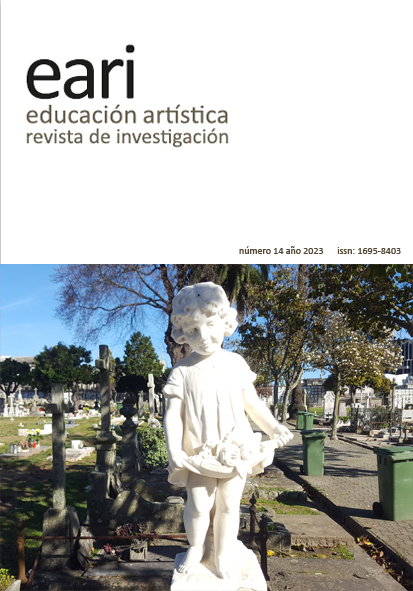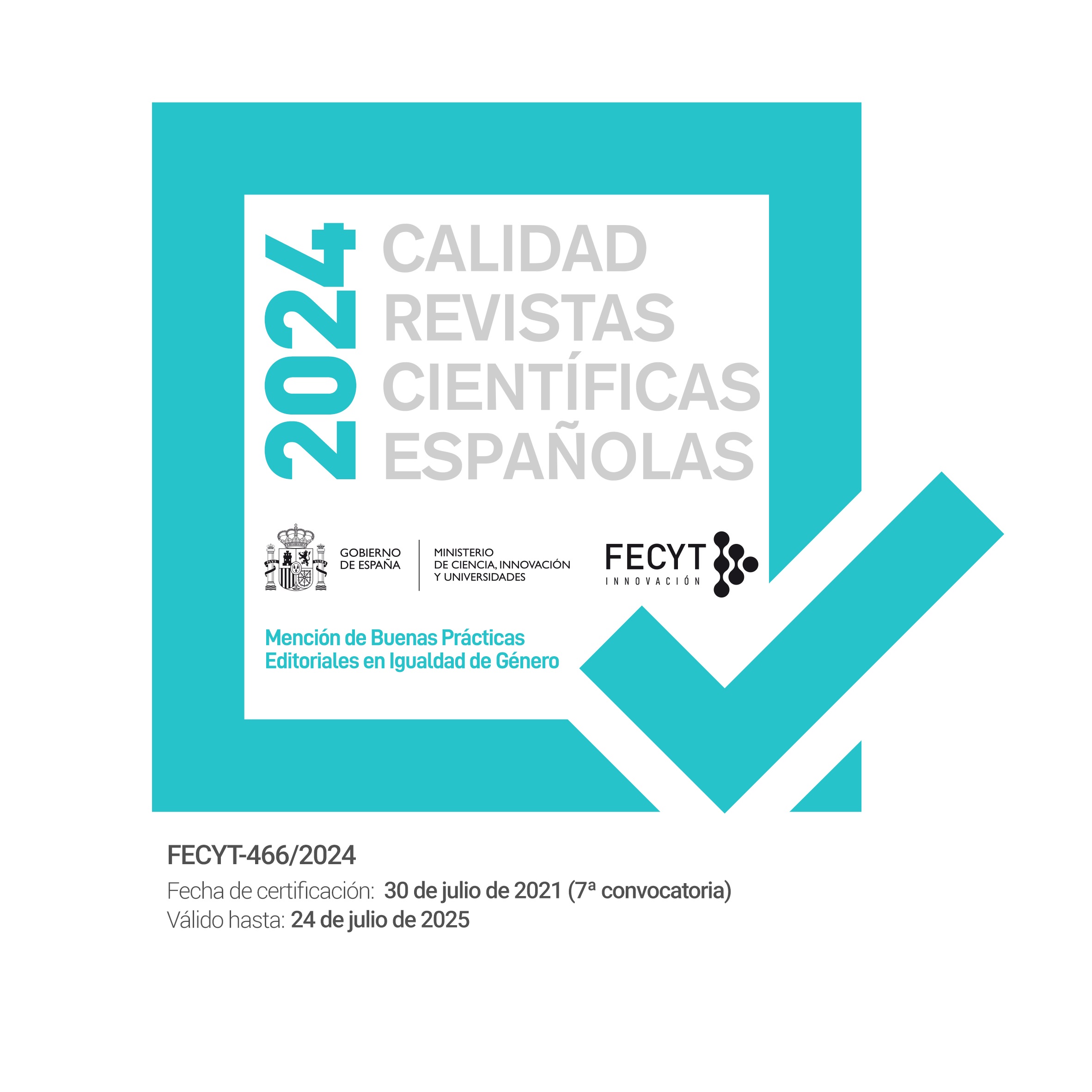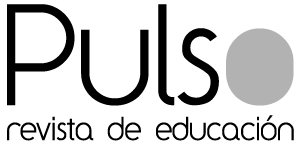Artificial intelligence. Synergies between humans and creative algorithms
DOI:
https://doi.org/10.7203/eari.14.27945Keywords:
Artificial Intelligence, digital education, creativity, digital transition, university teaching Abstract
Abstract
Artificial Intelligence has become one of the most attractive scenarios of today, both in the field of art and education, as in any other field of knowledge and human experience. Artificial Intelligence fills headlines and front pages, its presence is of such caliber that we almost suffer a real overdose of stimuli related to AI, to the point of finding ourselves in a second process of "technology fatigue", taking into account the relationship established between Artificial Intelligence processes and our excessive use of screens, mobile devices and digital technologies. As the people in charge of EARI Educación Artística: Revista de Investigación, we see ourselves in the position of addressing the topic, and we do so as professionals who have always bet on digital technologies (Huerta and Domínguez, 2019, 2020; Domínguez, 2019; Huerta, 2020). We are fascinated by the digital technological scenario, and we think it represents a future challenge for arts education.
 Downloads
Downloads
 References
References
Alfonso-Benlliure, V. (2022). Tu mirada es tu firma: el concepto de Encontrar Problemas (Problem Finding). Revista Creatividad y Sociedad, 37, 62-73.
Allaoua-Chelloug, S., Ashfaq, H., Alsuhibany, S., Shorfuzzaman, M., Alsufyani, A., Jalal, A. y Park, J. (2023). Real objects understanding using 3D haptic virtual reality for e-learning education. Computers, Materials & Continua, 74(1), 1607-1624. https://doi.org/10.32604/cmc.2023.032245
Barrios-Tao, H., Díaz, V. y Guerra, Y. M. (2021). Propósitos de la educación frente a desarrollos de inteligencia artificial. Cadernos de Pesquisa, 51, artículo e07767. https://doi.org/10.1590/198053147767
Cancela, E. (2023). Utopías digitales. Imaginar el fin del capitalismo. Verso.
Domínguez, R. (2019). Entornos personales de aprendizaje en la formación de docentes de la especialidad de Dibujo. Tesis doctoral. Universitat de València.
Durand, C. (2021). Tecnofeudalismo. Crítica de la economía digital. Kaxilda.
Educause Horizon Report (2023). Teaching and Learning Edition. https://library.educause.edu/resources/2023/5/2023-educause-horizon-report-teaching-and-learning-edition
García-Peñalbo, F. J. (2023). La percepción de la Inteligencia Artificial en contextos educativos tras el lanzamiento de ChatGPT: Disrupción o Pánico. Education in the Knowledge Society, 24, 1-9. https://doi.org/10.14201/eks.31279e31279
García Villarroel, J. J. (2021). Implicancia de la inteligencia artificial en las aulas virtuales para la educación superior. Orbis Tertius UPAL, 5(10), 31-52.
Girò Gràcia, X. y Sancho-Gil, J. M. (2021). Artificial Intelligence in Education: Big Data, Black Boxes, and Technological Solutionism. Seminar.net, 17(2). https://doi.org/10.7577/seminar.4281
Han, B.-Ch. (2021). No-cosas. Quiebras del mundo de hoy. Taurus.
Han, B.-Ch. (2023). Vida contemplativa. Elogio de la inactividad. Taurus.
Hartong, S. y Förschler, A. (2019). Opening the black box of data-based school monitoring: Data infrastructures, flows and practices in state education agencies. Big Data & Society. https://doi.org/10.1177/2053951719853311
Huerta, R. (2020). Arte, género y diseño en educación digital. Tirant.
Huerta, R. (2021). Patrimonios, tecnologías y periferias en Educación Artística: encuentro con Olaia Fontal, Ricardo Domínguez y Rosa Cubillo. Educación Artística: Revista de Investigación EARI, 12, 355-370. https://dx.doi.org/10.7203/eari.12.21960
Huerta, R. (ed.) (2022). Videojuegos y creatividad. Pedagogías culturales en el universo digital. Tirant lo Blanch.
Huerta, R. (2023). Diseño y sostenibilidad. Tirant lo Blanch.
Huerta, R., y Alfonso-Benlliure, V. (2023). Creatividad e implicación docente. Análisis de factores que influyen en el respeto a la diversidad sexual del alumnado de secundaria. Aula Abierta, 52(1), 7–14. https://doi.org/10.17811/rifie.52.1.2023.7-14
Huerta, R. y Domínguez, R. (2019). La educación artística de la era digital: investigar en escenarios tecnológicos. Educación Artística: Revista de Investigación EARI, 10, 9-20. http://dx.doi.org/10.7203/eari.1o.16111
Huerta, R. y Domínguez, R. (2020). Por una muerte digna para la educación artística. Educación Artística: Revista de Investigación EARI, 11, 9-24. http://dx.doi.org/10.7203/eari.11.19114
Huerta, R. y Navarro Espinach, G. (2023). Diseñar un museo virtual. McGraw-Hill.
Huerta, R. y Soto-González, M. D. (2022). Museari como recurso digital para activar el pensamiento reflexivo en estudiantado universitario. Communiars. Revista de Imagen, Artes y Educacion Crítica y Social, 8, 25-42. https://dx.doi.org/10.12795/Communiars.2022.i08.02
Jara I. y Ochoa J.M. (2021). Usos y efectos de la inteligencia artificial en educación. Publicaciones. https://publications.iadb.org/publications/spanish/document/Usos-y-efectos-de-la-inteligencia-artificial-en-educacion.pdf
Jaron, L. (2023). Contra el rebaño digital. Un manifiesto. Penguin Random House.
Lecun, Y. Bengio y G. Hinton, (2015). Deep learning. Nature.
Marzo, J. L. (2021). Las videntes. Imágenes en la era de la predicción. Arcadia.
Mascarell-Palau, D. (2017). Les TIC en la formació universitària de Mestres. El telèfon mòbil en Didàctica de l’Expressió Plàstica a la Facultat de Magisteri de la Universitat de València. Tesis Doctoral. Universitat de València.
Mascarell-Palau, D. (2021). Convergencias artísticas y virtuales mediadas por las NTIC’s en la sociedad de la imagen con dispositivos móviles. Tsantsa. Revista de investigaciones artísticas, 12, 21-34. https://doi.org/10.18537/tria.12.01.03
Mascarell-Palau, D. (2022). Del teléfono móvil al smartphone: Un recorrido evolutivo del dispositivo móvil hacia implicaciones educativas y artísticas con la imagen. H-ART. Revista de historia, teoría y crítica de arte, 12, 195-218. https://doi.org/10.25025/hart12.2022.10
Marín Viadel, R. (2023). Inteligencia Artificial y educación artística, saludo (IA+EA). EUG.
Moreno, R. (2019). La llegada de la inteligencia artificial a la educación. RITI Journal, 7(14). https://doi.org/10.36825/RITI.07.14.022
Parra-Sánchez, J. (2022). Potencialidades de la Inteligencia Artificial en Educación Superior: Un Enfoque desde la Personalización. Revista Tecnológica-Educativa Docentes 2.0, 14(1), 19-27. https://doi.org/10.37843/rted.v14i1.296
Rivas, A. (2018). Un Sistema Educativo Digital para la Argentina. CIPPEC, 164.
Sánchez, V.; Navarro, J. y Rosas, L. (2021). Aplicaciones de la inteligencia artificial en educación: un panorama para docentes y estudiantes. XVI Congreso Nacional de Investigación Educativa. https://comie.org.mx/congreso/memoriaelectronica/v16/doc/2050.pdf
UNESCO (2021). Artificial intelligence in education: challenges and opportunities for sustainable development – Unesco Biblioteca Digital. https://unesdoc.unesco.org/ark:/48223/pf0000366994
Downloads
Published
How to Cite
-
Abstract1381
-
PDF (Español)780
Issue
Section
License
![]()
Educación artística: revista de investigación (EARI) retains the proprietary rights (copyright) of published works, and favors and allows the reuse of the same under the license Creative Commons Attribution-Noncommercial Use 4.0 International License (CC-BY-NC 4.0), which allows third parties to use the published material whenever the authorship of the work and the source of publication is mentioned (journal, publisher and URL of the work), and it is used for non-commercial purposes.
Authors are encouraged to disseminate their work after it has been published, through the internet (for example, in institutional archives online or on its website) which can generate interesting exchanges and increase work appointments.








